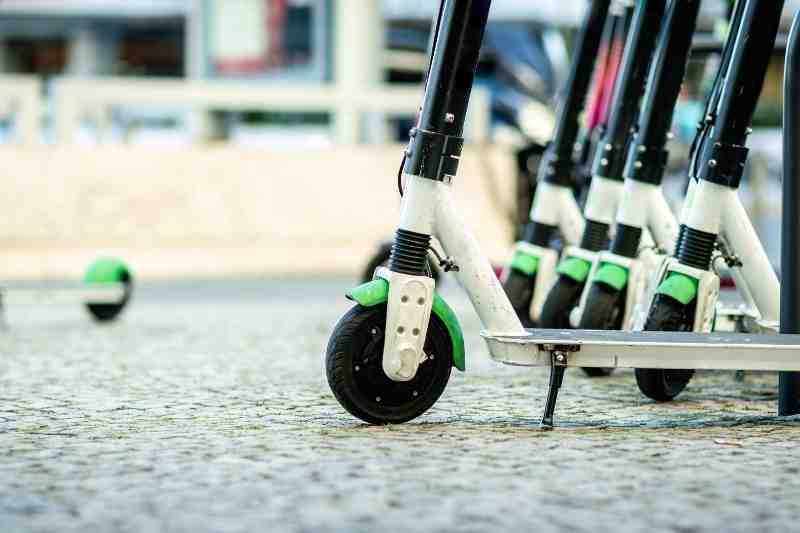Key takeaways
- As younger generations exert more and more influence on the multifamily and commercial markets, micromobility will serve as a way to address their top concerns and appeal to their interests. And there are concrete steps you can take to make your property friendly to micromobility.
- Micromobility infrastructure investments — like providing on-site vehicle storage, charging stations, and supporting bike lanes in your property and the neighborhood — ensure that the future of micromobility benefits you as much as it does your residents.

Real estate, transportation trends, and the needs of residents have always gone hand in hand. Countless parking lots and garages have sprung up to meet the needs of people with cars. But the automobile isn’t always going to be king. In fact, in some places, cars are already losing popularity to newer transportation trends, like micromobility. So what’s the future of micromobility, and how will it affect your tactics as a developer?
In this post, we explain what micromobility is and why it’s gaining popularity today. Then, we explain how micromobility will affect real estate development, and go over some ways you can develop properties to support micromobility.
This post covers:
- What is micromobility?
- Why is micromobility gaining popularity today?
- How is the future of micromobility affecting real estate development?
- How to develop properties that favor micromobility
What is micromobility?
Micromobility is a transportation movement that encourages urban residents to use small, one-person vehicles to travel short distances as a supplement to walking or public transportation. Common examples of micromobility vehicles are bikes and scooters, which can be powered by electricity or by human locomotion.
Micromobility is a trend that’s been centuries in the making. The first human-powered bicycle was invented all the way back in 1817. However, urban planners and other innovators really started to embrace the power of these smaller vehicles in an urban environment after taking a look at city transit patterns and studying how people moved around.
Proponents of micromobility want to use bikes and scooters to reduce the traffic and car-related congestion that comes with heavy automobile usage. And micromobility vehicles are small, portable, light, and produce fewer emissions than cars. Innovators see the potential for micromobility to become a new fixture in urban transportation and inclusive architecture.
Watch how ButterflyMX works:
Why is micromobility gaining popularity today?
Micromobility is gaining popularity today because modern urban residents are prioritizing sustainability, reducing emissions, and personal health. Micromobility checks all those boxes — with the added benefit of a scooter or a bike just being fun to ride.
Younger generations of renters, like millennials and Gen Z, are approaching living, working, and playing in cities with a whole new mindset. Even though remote work is the norm, cities continue to appeal to Gen Z because they offer cultural and recreational opportunities and a public transport system that supports car-free living.
But not all neighborhoods in a city are created equal. Some properties today are situated in the middle of transit deserts. That’s a term for any place where walkability is low and public transport is not easily accessible.
And even in a neighborhood where there are plenty of public transit options, residents can still run into problems. What should a resident do if their destination is too far away to justify using public transit, but walking there would take too long?
The answer to that question used to be getting into a car. But younger generations are using automobiles less and less. They cite drawbacks like sitting in traffic, car maintenance and gas costs, and contributing to greenhouse gas emissions as reasons to ditch cars.
So, micromobility solution providers are stepping up to fill the gap, giving city residents new transportation alternatives.
How is the future of micromobility affecting real estate development?
Whether you’re developing a residential, commercial, or mixed-use property, we’re at the beginning of an urban micromobility trend that will shape cities and towns across the world for decades.
Residents aren’t the only ones who will benefit from the convenience that comes with transit access and micromobility. Real estate developers who anticipate this trend and design today’s properties with micromobility in mind will have the most desirable properties on tomorrow’s market.
Location is one of the biggest factors for any tenant choosing a property to rent. The value of your property might be lower if it’s harder to get to or out of the way.
By developing for micromobility, you can ensure that location isn’t a concern to prospective tenants. Micromobility infrastructure is also an additional amenity that will allow you to charge higher rents.
However, the benefits of micromobility only apply to smart city developers. Read on to learn about what you can do to develop properties that favor micromobility.
How to develop properties that favor micromobility
Here are three ways to develop properties that favor micromobility:
- Provide on-site storage for bikes and scooters
- Support the addition of bike lanes on/through your property
- Invest in charging infrastructure

1. Provide on-site storage for bikes and scooters
Existing properties that embrace the micromobility landscape might repurpose an old storage locker or closet to store bikes and scooters. But as a developer, you have the power to design and designate a specific area of your property for micromobility storage. This shows residents you had sustainability and ease of transportation in mind since day one.
A garage designed for smaller vehicles also has the benefit of being cost-effective because you’ll be able to fit a lot of compact bikes or scooters into a small space.
2. Support the addition of bike lanes on and through your property
While your city or municipal government is the body in charge of putting up bike lanes, they count on voices like yours to represent the local community and help decide the character of the neighborhood. So, support micromobility by supporting the citywide infrastructure that makes micromobility so convenient, like bike lanes.
Properties near bike lanes are more highly valued. And, residents consistently list bike lanes as an amenity that helps decide whether they move into a neighborhood or not. Make sure you can reap these benefits by supporting lanes for bikes or scooters.
3. Invest in charging infrastructure
Finding a dedicated place for charging stations will go a long way in the eyes of residents using electric bikes or scooters. And a dedicated charging area could also double up as a storage area, allowing you to fulfill two vital micromobility needs at once.
Consider using renewable energy, like solar power, to help power these charging stations. Another benefit of solar panel usage: You can possibly sell any excess power you generate back to your local power grid, which benefits both the environment and building ownership.






